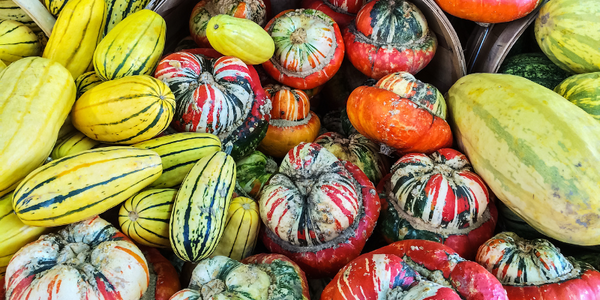Posted on June 01 2020

Where is it written in stone that if you don’t have a lot of money for food that you have to eat ramen? Some college students practically lived on the stuff when money was tight. After doing some number crunching, you might find you could eat a lot better for about the same amount. During these increasingly difficult financial times, you can keep your food budget under control with these simple steps.
Take a realistic look at your budget. Figure out how much you can spend per meal. Then make your grocery list based on how many meals you can get for your dollar. A $6.00 jar of peanut butter might seem expensive, but think about how many sandwiches a jar of peanut butter makes. Provided you don’t get too fancy, even once you factor in the cost of bread and jam, a peanut butter sandwich makes a meal for less than $0.50.
The bulk food aisle is your friend. Many stores sell staples like flour, sugar, and various grains cheaper out of bulk bins. If you don’t want a specific brand, you can save a lot of money here. Scoop out however much you want into the plastic bags the store provides, and transfer to your own containers at home. Vacuum seal to keep them even longer.
Stay away from prepared meals. You can make it cheaper and often better yourself. Why spend $5.00 on a soggy fried chicken TV dinner when you can buy a whole chicken, fry it yourself, and get five dinners out of it for half that? Plus you get to choose your own sides to boot. Any leftovers can be vacuum sealed for another delicious meal later.
Keep an eye on the newspapers. Grocery stores usually include flyers in the newspaper on Sundays and in the middle of the week announcing their sales. This gives you an excellent chance to comparison shop without having to go anywhere. The paper is also a good source of coupons, but be careful not to let a coupon sway you into buying something you wouldn’t normally use.
Eat fresh fruits and vegetables in season. While it’s possible to get fresh fruits and veggies at any time of the year, the prices are affected by shipping costs, as well as supply and demand. When a fruit or vegetable is in season, there’s more supply and so prices fall. It’s easy to find berries and tomatoes cheap in the summer, but in the winter they have to be grown indoors or shipped from warmer climates. This leads to higher prices and possibly inferior quality.
Read the labels and estimate costs. Just because the smaller bottle of barbeque sauce costs less than the big bottle doesn’t necessarily mean it’s cheaper compared to the amount you get. That doesn’t necessarily mean it’s more expensive, either. Stores are required by law to print the cost of food per unit on their price tags. It’s usually in microscopic print, but it is always there.
Compare the cost per unit, but pay attention to how much you will realistically use. If the small bottle is 10 ounces for $1.50 and the large bottle is 22 ounces for $3.00, then you should buy the large bottle as long as you know you will use it all. You won’t save money buying the bigger bottle if it goes bad before you use it and you end up having to throw it out.
Take along a calculator to avoid confusion. While stores have to print the price per unit, sometimes the units of measurement aren’t always the same. A six pack of soda might be priced per can, while a two liter bottle of the same soda might be priced per fluid ounce, for example. You may already have one, since most modern cell phones have a calculator function built in.
Some foods that are perishable can be kept for long periods in the freezer. You can save money by stocking up on meat when it’s on sale and freeze it, for example. Air is the enemy of food in the freezer. It causes freezer burn and wastes space. You can make do by submerging the freezer bag in a bucket of water as you seal it. This forces most of the air out, but not all.
A vacuum sealer is necessary to really get the job done. It draws out all the air, allowing you to keep food free of freezer burn for longer periods and saving valuable freezer space. You don’t need one with all the bells and whistles. An affordable vacuum sealer can be bought new for around $70. This might still seem like a lot on a budget, but it quickly pays for itself by allowing you to make recipes in large batches and throw away less food.
Another money and time saving kitchen gadget is the humble Crock Pot, or slow cooker. These holdovers from your mother’s kitchen are surprisingly versatile. They excel at cooking cheaper cuts of meat that require moisture and long cooking times to become tender. Many recipes can be prepared the night before and kept in the refrigerator overnight for cooking while at work or school the next day.
You don’t have to live on the same thing to keep your food budget to a reasonable level. By calculating the cost of your meals, paying close attention to price labels, and thinking ahead, you won’t be doomed to eating salty noodles three meals a day.
By S. Ranta
Related Posts

Embrace Fall with a Love for Apples and Sous Vide Cooking

Three Types of Squash to Add to Your Fall Grocery List



Hi Vicky – Another great use for our vacuum seal bags! Good thinking!
I needed to ship fabric to a friend to make masks. However, the size of the ‘If it Fits is Ships’ box was too small. So, I took the fabric, folded it tight, vacuum sealed fabric in bags, then fit it into the small box. My friend couldn’t believe how much fabric was in the box!! Plus the fabric stayed fresh instead of smelling like a box.
Here’s one that I thought was crazy, but it works!
We stopped at a food distribution center and as I went into the front door, there was a 1 quart zip bag 1/2 full of water pinned to the edge of the door. Okay, I hadn’t been drinking so had to ask, what gives?
The reply was “it keeps the flies out because it confuses their sight.” Yeah, right!
We filled a 6" bag with ice cubes (full) and pinned it to the back door, dogs you know.
We have had about 4 flies in the house since then and the dogs are in and out all day long.
Try it, goofy sounding, but it works for us.
I have been vacuum sealing for ages. Learning from trial and error, I have learned the most effective way to vacuum & freeze meats.
First wrap the meat individually in stretchy plastic wrap trying to minimize air pockets. Freeze for 24 hours. Then unwrap each item and quickly rinse under cold water and wipe off most of the water. Then vacuum seal. This process does 2 very important things: 1) it avoids sucking the juices out of the meat when vacuum sealed unfrozen (resulting in dry meat); 2) it utterly eliminate tiny air pockets that will ruin the product.